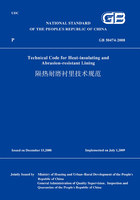
5.3 Erection of Anchors
5.3.1 Welding of anchors shall be in accordance with the current national standard JB/T 4709:Welding Specification for Steel Pressure Vessels.
5.3.2 If post weld heat treatment(PWHT)is required for equipment,anchors shall be welded prior to PWHT.
5.3.3 The distance from anchor and ring anchor to the welds in equipment wall should not be less than 50mm,and the following requirements shall be followed:
1 Cylindrical anchor shall be fully welded to the equipment wall around the foot of anchor,and shall be perpendicular to the equipment wall.
2 Ω-anchors shall be welded along its straight section on both sides,and the length of weld on each side shall not be less than 25mm.
3 Y-anchors shall be fully welded at its wide section on both sides.
4 V-anchors shall be fully welded at its straight section on both sides.
5 S-anchors shall be fully welded along its long edge on both sides,and shall be perpendicular to the equipment wall.
6 Single-layer ring anchor shall be welded on its exterior wall in every 120°,and the length of each weld shall not be less than 20mm.
7 Stud bolt of dual-layer ring anchor shall be fully welded to the wall around the foot of bolt and shall be perpendicular to the wall,and its ring anchor shall be erected after completion of heat-insulating concrete application.

Figure 5.3.4 Schematics of Full Weld between Cylindrical Anchor and End Plate
5.3.4 Cylindrical anchor of heat-insulating and abrasion-resistant lining with hexmesh shall be first welded to end plate,and double welding shall be used(Figure 5.3.4).End plate shall be closely placed onto the shoulder of anchor,and shall be perpendicular to anchor.
5.3.5 Pre-layout shall be made before cut-off of hexmesh,and overlap margins shall be provided.Wire scissors shall be used to cut off hexmesh,and hot cutting shall not be used.
5.3.6 When hexmesh is rolled and formed,its rolling direction shall be consistent with the length direction of steel strips,and knots shall be free of any cracking and detachment.And any detached knot shall be fully welded along the depth of hexmesh.
5.3.7 End-point splicing or parallel splicing may be used to joint two pieces of hexmesh(Figure 5.3.7).
5.3.8 Splicing methods shown in Figure 5.3.8 may be used for the hexmesh directly welded to the wall,and the splicing methods shown in Figure 5.3.7 may be also used.When hexmesh is welded to the wall,welds shall be made at the joint of two pieces of hexmesh and the intersection of two steel strips(Figure 5.3.8),but shall not be made at the knot of steel strips of hexmesh.Mesh openings in each row shall be welded every other mesh opening,and end of hexmesh shall be fully welded to the wall.
5.3.9 Hexmesh splicing shall comply with the following requirements:
1 The area of mesh opening at the joint of two pieces of hexmesh shall not be less than 1/2 and shall not be larger than 4/3 of that of original mesh opening.
2 Longitudinal joints of two adjacent pieces of hexmesh shall be staggered more than 300mm.

Figure 5.3.7 Hexmesh splicing methods

Figure 5.3.8 Schematics of splicing and weld arrangement of hexmesh welded to wall
1—Back plate;2—Hexmesh;3—Splicing strip
3 The clearance and misalignment of knots after hexmesh erection shall not be larger than 0.5mm.
4 If hexmesh is directly welded to the wall,it shall be closely placed to the wall,and the clearance between hexmesh and wall shall not be larger than 1mm.
5.3.10 Water,rust,oil stains,collected dregs and other impurities shall not exist on the surface of anchor to be welded and within an extent in 10mm beyond the surface of anchor.
5.3.11 All fillet welds and overlap welds for anchors shall have their leg height not less than the thickness of thinner pieces,and shall be continuously welded.